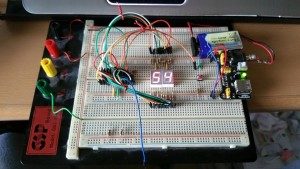I have now improved on my Arduino dice by adding a second digit. The code can be found below. I have streamlined the code a bit but I left the constants in place so that it is easy to keep track of which pin is connected to which led segment. I get confused easily so I have to make it simple to change if neccessary!

#define LED1_A 6
#define LED1_B 5
#define LED1_C A3
#define LED1_D 12
#define LED1_E A0
#define LED1_F 7
#define LED1_G 8
#define LED1_H 13
#define LED2_A 2
#define LED2_B 3
#define LED2_C A5
#define LED2_D A4
#define LED2_E A2
#define LED2_F 9
#define LED2_G 10
#define LED2_H 11
#define BUTTON 4
const int leds[2][8] = {
{LED1_A, LED1_B, LED1_C, LED1_D, LED1_E, LED1_F, LED1_G, LED1_H},
{LED2_A, LED2_B, LED2_C, LED2_D, LED2_E, LED2_F, LED2_G, LED2_H}
};
char digits[10][7] = {
{HIGH, HIGH, HIGH, HIGH, HIGH, HIGH, LOW},
{LOW, HIGH, HIGH, LOW, LOW, LOW, LOW},
{HIGH, HIGH, LOW, HIGH, HIGH, LOW, HIGH},
{HIGH, HIGH, HIGH, HIGH, LOW, LOW, HIGH},
{LOW, HIGH, HIGH, LOW, LOW, HIGH, HIGH},
{HIGH, LOW, HIGH, HIGH, LOW, HIGH, HIGH},
{HIGH, LOW, HIGH, HIGH, HIGH, HIGH, HIGH},
{HIGH, HIGH, HIGH, LOW, LOW, LOW, LOW},
{HIGH, HIGH, HIGH, HIGH, HIGH, HIGH, HIGH},
{HIGH, HIGH, HIGH, HIGH, LOW, HIGH, HIGH}
};
int seed1;
int seed2;
int num1 = 0;
int num2 = 0;
int buttonState = 0;
const int delaid = 400;
void setup() {
Serial.begin(9600);
pinMode(A1, INPUT); // random seed generator
for (int i = 0; i < 2; i++) {
for (int j = 0; j < 8; j++) {
pinMode(leds[i][j], OUTPUT);
digitalWrite(leds[i][j], LOW);
}
}
seed1 = analogRead(1);
pinMode(BUTTON, INPUT);
}
void loop() {
buttonState = digitalRead(BUTTON);
Serial.println(buttonState);
if (buttonState == HIGH) {
num1 = random(1, 7);
num2 = random(1, 7);
} else {
disp(0, digits[num1]);
disp(1, digits[num2]);
}
}
void disp(int led, char segment[]) {
for (int i = 0; i < 7; i++) {
digitalWrite(leds[led][i], segment[i]);
}
}